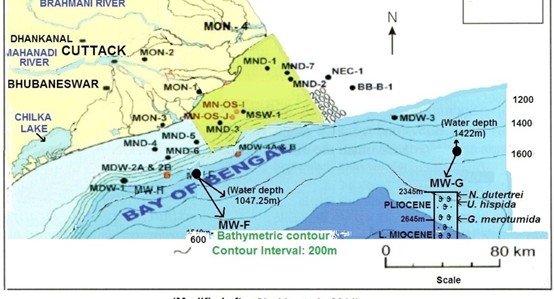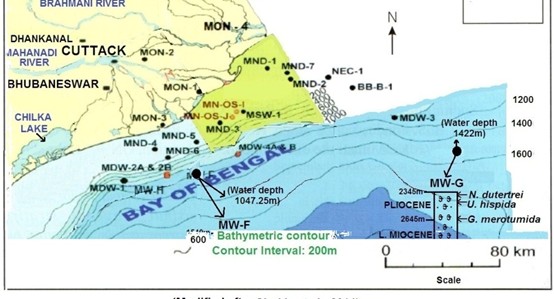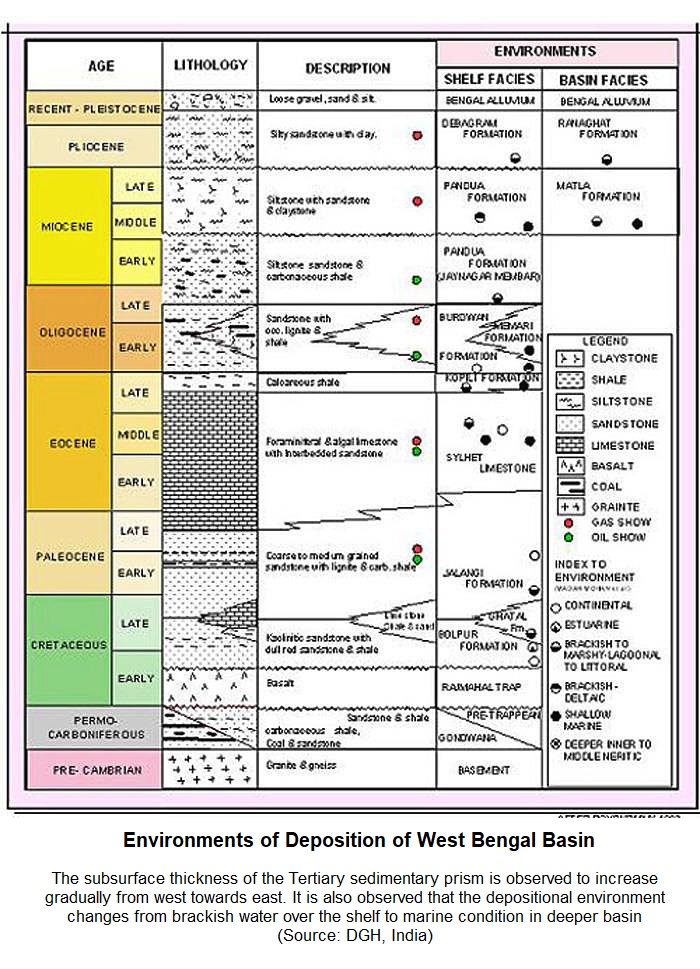Kalighat Fm
Type Locality and Naming
Type section (West Bengal Basin) is in well Domjur-1, Interval is 3845-4640 m and thickness is 795 m. SUBSURFACE: Well MND-2, Interval is 2497-3298 m and thickness is 801 m. [Original Publications: (1) Chandra, M., Mallik, S., Das, D., Thakur, R.K., and Sinha, M.K. (1993) Lithostratigraphy of Petroliferous Basins, Document IX, West Bengal Basin, KDMIPE ONGC Publication, pp 1-216. (2) Raju D.S.N, Dwivedi R.N, Misra Ravi, Stratigraphy of Mahanadi Basin, (2009) pp 293-296 in Raju and Misra (2009), ONGC Bulletin, Vol. 44, no.2]. Reference wells in Mahanadi Basin: Well, MND-2, Interval is 2497-3298 m and thickness is 801 m; MND-3; Interval is 1782 2500 m and thickness is 718 m.
[Figure 1: Location map showing tectonic elements and drilled wells in West Bengal Basin (after R.N Dwivedi in Raju and Misra, 2009)]
[Figure 3: The lithocolumn of the Reference (Hypo) section of the Kalighat Formation in Well MND - 3 showing the foraminiferal assemblage, age, and paleobathymetry (after Pandey, J., ONGC, 1986)]
Synonyms: Sequence-II of Mahapatra (2006); Mahanadi stages-M1 to M5 of Pandey, 1986.
Lithology and Thickness
Sandy limestone and marl. In the type section, it consists of a number of limestone bands separated by clastics. The limestone is grey or buff colored and the clastics are represented by fine- to medium-grained, glauconitic sandstone and shale. In type section, its thickness is 795 m; and ranged 300-800 m thickness.
UNIT(S) – The entire Kalighat in West Bengal Basin is divisible into three units: lower, middle and upper.
(1) The lower Kalighat is represented by alternation of sandy limestone and sandstone or shale.
(2) The middle Kalighat is characterized by thick compact limestone body with little or no clastics.
(3) The upper Kalighat is characterized by occurrence of a coarse- to fine-grained sandstone topped by a limestone band.
The bottom of this formation consists of a package of alternating sand and shale. Major part of the formation consists predominantly of calcareous or intercalated with thin sandstone layers. The limestones are fossiliferous. Layers of calcareous shale occur in the upper part.
[Figure 1: West Bengal Basin lithostratigraphy (after R.N. Dwivedi in Raju and Misra, 2009) with red-arrow showing position of this formation]
[Figure 1: Location Map of well MND -8 (modified after Shukla et al., 2014)]
[Figure 2: The lithocoloumn of the type (Holo) section of the Kalighat Formation in Well MND - 2 showing the foraminiferal assemblage, age, and paleobathymetry (after Pandey, J., ONGC, 1986)]
Relationships and Distribution
Lower contact
Lower boundary in Mahanadi Basin coincides with K-Pg boundary (KTB), a major unconformity with base level fall and hiatus of 5-6 Myr equivalent to Danian Stage. In West Bengal Basin, lower boundary is unconformable with the Jalangi Fm.
Upper contact
Upper boundary in Mahanadi Basin to Chilika Fm is a pronounced erosional unconformity and subaerial exposures with major hiatus. In West Bengal Basin, Upper boundary is with Hooghly Fm
Regional extent
GeoJSON
Fossils
The Basal part contains Daviesina longhami and Lockhartia haimei. The Lower Kalighat in West Bengal Basin is characterized by: Nummulites globulus, Assilina granulosa, A. laminosa, A. daviesi, Fasciolites oblonga, Lockhartia hunti, L. conditi, L. haimei. The Middle Kalighat is characterized by N. burdigalensis, N. globulus, N. dijodjokartae, Assilina spira, A. placentula, Fasciolites elliptica. In the Upper Kalighat N. fabianii, Pellatispira glabra and P. madraszi are characteristic.
In Mahanadi Basin, The Early Eocene interval yielded Flosculina oblonga, Nummulites burdigalenis, N. globules, N. praelucasi, Lockhartia hunti and L. conditi. The Middle Eocene strata contain Nummulites djodjokarte. M. discorbinus, Flosculiina elliptica and Assilina spira. The Late Eocene strata yielded Pellatispira inflate and Nummulites fabianii. In the reference section additional foraminifera including Globorotalia uncinata and Lockhartia retiata are found.
Age
Depositional setting
Stable marine shelf. The lowest sands represent marginal marine condition. In West Bengal Basin, the faunal assemblage recorded indicate shallow inner shelf condition with minor pulses of regression in an overall transgressive phase.
Additional Information




 section.jpg)
 section of the Kalighat Formation.jpg)
